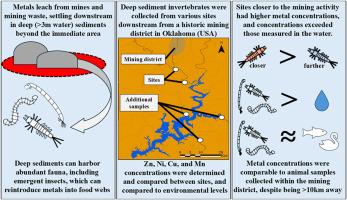历史矿区下游底栖无脊椎动物沉积物中重金属的积累
IF 7.3
2区 环境科学与生态学
Q1 ENVIRONMENTAL SCIENCES
引用次数: 0
摘要
金属开采造成了巨大的生态影响,其影响在采矿活动停止后仍将持续很长时间。金属可从废弃矿山和采矿废物(即“废物”)中渗入水体,影响原生生物群和相关过程。通常,金属沉淀或以其他方式离开水柱,沉积在深层沉积物中。这些深层沉积物可能密集地聚集着未成熟的昆虫和其他无脊椎动物;然而,在生态系统影响的评估中,它们往往被忽视。我们的研究评估了从位于Tar Creek下游的深层沉积物(>; 3m深度)中收集的常见大型无脊椎动物的重金属浓度,Tar Creek是位于历史悠久的三州矿区(美国俄克拉荷马州/堪萨斯州/密苏里州)的铅和锌矿区。在美国俄克拉荷马州东北部的Neosho河和Grand湖的多个地点收集了大型无脊椎动物、水和沉积物样本。采用电感耦合等离子体发射光谱法测定了17种元素的浓度。在Neosho河- tar溪汇合处附近收集的无脊椎动物中观察到的锌浓度高于下游收集的无脊椎动物。此外,无脊椎动物的金属浓度高于所收集的环境样本,也高于以往研究中收集的生物样本。虽然这些浓度似乎是亚致死的,但本研究表明,TCSS的影响会向下游扩散。此外,该研究强调了在评估污染物对水生生态系统的影响时将深层沉积物动物群包括在内的重要性。这些深层沉积物组合可能含有高浓度的金属,并通过出现将这些污染物重新引入水生和陆地食物网。本文章由计算机程序翻译,如有差异,请以英文原文为准。

Heavy metal accumulation in deep sediment benthic invertebrates downstream from a historical mining district
Metal mining has resulted in substantial ecological impacts, with effects lasting long after mining activity has ceased. Metals can leach from abandoned mines and mining waste (i.e. “chat”) into waterbodies, affecting the native biota and associated processes. Often, metals precipitate or otherwise leave the water column, depositing in deep sediments. These deep sediments can be densely populated with immature insects and other invertebrates; however, they are often ignored in the assessment of ecosystem impacts. Our study assessed heavy metal concentrations in common macroinvertebrates collected from deep sediments (>3 m depth) located downstream of Tar Creek, a stream draining Pb and Zn minefields in the historic Tri-State mining district (Oklahoma/Kansas/Missouri, USA). Macroinvertebrate, water, and sediment samples were collected at multiple sites in the Neosho River and Grand Lake in northeast Oklahoma (USA). The concentrations of 17 elements were determined using inductively coupled plasma optical emission spectroscopy. Higher concentrations of Zn were observed in invertebrates collected near the Neosho River-Tar Creek confluence than in invertebrates collected further downstream. Additionally, metal concentrations were higher in invertebrates than in the environmental samples collected, and higher than biological samples collected in previous studies. Although these concentrations appear to be sublethal, this study demonstrates the downstream spread of impact from the TCSS. Additionally, the study highlights the importance of including deep sediment fauna when assessing the impact of pollutants on aquatic ecosystems. These deep sediment assemblages can harbor high concentrations of metals, and through emergence reintroduce these pollutants to aquatic and terrestrial food webs.
求助全文
通过发布文献求助,成功后即可免费获取论文全文。
去求助
来源期刊

Environmental Pollution
环境科学-环境科学
CiteScore
16.00
自引率
6.70%
发文量
2082
审稿时长
2.9 months
期刊介绍:
Environmental Pollution is an international peer-reviewed journal that publishes high-quality research papers and review articles covering all aspects of environmental pollution and its impacts on ecosystems and human health.
Subject areas include, but are not limited to:
• Sources and occurrences of pollutants that are clearly defined and measured in environmental compartments, food and food-related items, and human bodies;
• Interlinks between contaminant exposure and biological, ecological, and human health effects, including those of climate change;
• Contaminants of emerging concerns (including but not limited to antibiotic resistant microorganisms or genes, microplastics/nanoplastics, electronic wastes, light, and noise) and/or their biological, ecological, or human health effects;
• Laboratory and field studies on the remediation/mitigation of environmental pollution via new techniques and with clear links to biological, ecological, or human health effects;
• Modeling of pollution processes, patterns, or trends that is of clear environmental and/or human health interest;
• New techniques that measure and examine environmental occurrences, transport, behavior, and effects of pollutants within the environment or the laboratory, provided that they can be clearly used to address problems within regional or global environmental compartments.
 求助内容:
求助内容: 应助结果提醒方式:
应助结果提醒方式:


